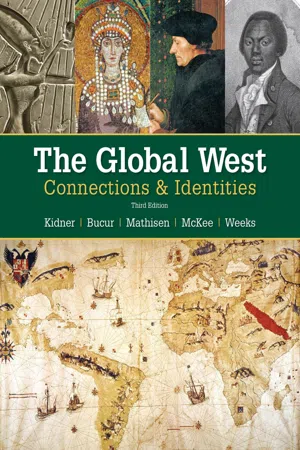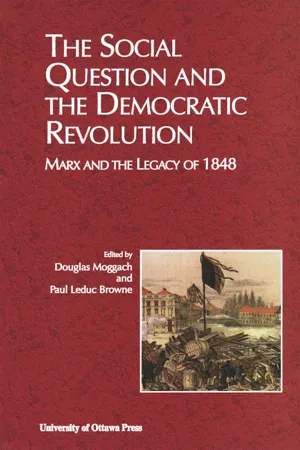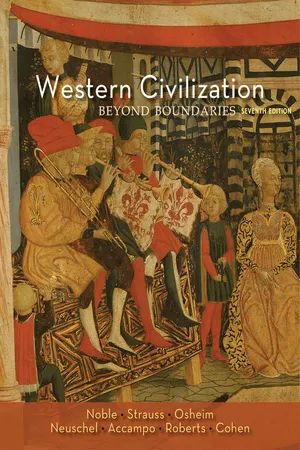History
Revolutions of 1848
The Revolutions of 1848 were a series of widespread uprisings and protests across Europe, driven by demands for political and social reforms. These revolutions were sparked by economic hardship, political repression, and a desire for national independence. Although they ultimately failed to achieve their goals, the events of 1848 had a lasting impact on European politics and society, paving the way for future reforms and nationalist movements.
Written by Perlego with AI-assistance
Related key terms
1 of 5
11 Key excerpts on "Revolutions of 1848"
- eBook - ePub
Revolutions and the Revolutionary Tradition
In the West 1560-1991
- David Parker(Author)
- 2002(Publication Date)
- Routledge(Publisher)
7 The Revolutions of 1848John BreuillyIntroduction
By comparison with the ‘great’ revolutions such as those of 1789 or 1917, the Revolutions of 1848 exhibit at least four peculiar features. First, the revolutionary outbreak was not preceded by political crisis triggered by conflict within the ruling order (1789) or failure in war (1917). Europe was at peace – there was no major war between 1815 and 1854. The ruling order did not appear to be badly split. There were tensions and disputes but nothing like political crisis.Second, revolution spread rapidly across Europe. Revolution extended beyond France in the 1790s and Russia after 1917 but principally promoted by the original revolutionary regime. In 1848 there was no national centre; virtually every part of Europe between Britain and Russia experienced revolution ‘from within’.Third, the revolutionary situation lasted for a comparatively short time. By the summer of 1849 counter-revolution had triumphed. The ‘great’ revolutions lasted, in terms of regime instability and civil war, at least until 1795 in France and 1921 in the USSR. Finally, in the judgement of many contemporaries and historians, the 1848 revolutions ‘failed’. Although the revolutions of 1789 and 1917 did not realise their proclaimed ideals, few would deny that they transformed both society and state and that the post-revolutionary world is unimaginable without them. It is more difficult to argue that case for 1848.These four distinguishing features provide keys to understanding the Revolutions of 1848. First, I outline and analyse the initial revolutionary outbreak and ask why so many governments collapsed so quickly. Second, I characterise the new revolutionary situation and ask how this could lead on to further political conflict. Third, I consider three broad political strands – radicalism, liberalism and conservatism – and how these combined to enable rapid counter-revolution. Finally, I link these arguments to broader comparative historical treatments of the revolutions and suggest how one should evaluate their significance. - eBook - ePub
The History of Democracy
A Marxist Interpretation
- Brian S. Roper(Author)
- 2012(Publication Date)
- Pluto Press(Publisher)
7
The Revolutions of 1848–49 INTRODUCTIONIn 1848 the wave of revolutionary upheavals that swept across Western and Central Europe combined ‘the greatest promise, the widest scope, and the most immediate initial success, with the most unqualified and rapid failure’ (Hobsbawm, 1975: 37). But if these revolutions failed to achieve the creation of lasting republican democracies loosely modelled on those of the French and American revolutions, nonetheless they profoundly shaped the future course of European history, demolishing what remained of serfdom in Western and Central Europe, forcing monarchs to make liberal concessions that resulted in the prevalence and persistence of parliamentary forms of governance in which property owners were more widely represented than before 1848, and leading to the creation of constitutional, juridical and political arrangements that were significantly more favourable to the development of capitalism.This chapter outlines the wider historical context and underlying causes of the 1848 revolutions, provides a brief descriptive overview of the main events in France, Germany, Austro-Hungary and Italy, considers the June insurrection of workers in Paris, describes the conservative counter-revolution that destroyed the new governments created during the initial phase of the revolutions, and finally identifies the common features and historical legacy of these revolutions.BACKGROUND AND CAUSESThe Revolutions of 1848 took place in the wider historical context of the transition from feudalism to capitalism, uneven development of capitalism across Europe, the rapid growth of industrial capitalism in Britain that provided the economic underpinning for the global expansion of the British Empire, and finally the growing pressure on France and Germany to introduce capitalist relationships in agricultural production and to industrialise in order to be able to compete with Britain’s growing economic and military power. Much of this has been discussed earlier. Nonetheless, it is important to recognise that the persistence of serfdom and feudal relationships in Central and Eastern Europe was a major cause of discontent among serfs and peasants, and was viewed as increasingly anachronistic by the bourgeoisie, state officials and enlightened members of the nobility. In this context maintaining the extraction of surplus product from peasants and workers as feudalism declined and capitalism developed was a major challenge for the landowning nobility and emerging bourgeoisie (Mooers, 1991: 27–40). - eBook - PDF
- Frank Kidner, Maria Bucur, Ralph Mathisen, Sally McKee(Authors)
- 2018(Publication Date)
- Cengage Learning EMEA(Publisher)
22-1a The Tide of Revolution The Revolutions of 1848 swept through nearly every European country (see Map 22.1). Only those on the periphery—Great Britain, Scandinavia, Russia, the Ottoman Empire—were spared. But even in these undisturbed regions, rulers and privileged classes were shocked and terrified. In Russia, for example, the govern-ment increased censorship and arrested radical thinkers. In Britain, increased police surveillance following the Chartist agitation prevented revolution, but Queen Vic-toria regarded the events on the continent with worry. The first uprising began in January 1848 in southern Europe, in Sicily. Street demonstrations in Palermo and Naples forced the reactionary ruler of the Kingdom of the Two Sicilies, as the southern Italian state was known, to form a liberal government and issue a constitution. These liberal concessions in one of the most conserva-tive regions of Europe electrified rulers and liberals alike. Revolutions of 1848 Series of upheavals that shook Europe from Sicily to Paris to Berlin to Vienna, bringing first liberal change, then gen-erally conservative reaction. Copyright 2019 Cengage Learning. All Rights Reserved. May not be copied, scanned, or duplicated, in whole or in part. Due to electronic rights, some third party content may be suppressed from the eBook and/or eChapter(s). Editorial review has deemed that any suppressed content does not materially affect the overall learning experience. Cengage Learning reserves the right to remove additional content at any time if subsequent rights restrictions require it. - eBook - ePub
The Roots and Consequences of Civil Wars and Revolutions
Conflicts That Changed World History
- Spencer C. Tucker(Author)
- 2017(Publication Date)
- ABC-CLIO(Publisher)
The chief causes of the Revolutions of 1848 were liberalism and nationalism. Virtually all national groups who were under the sway of other nationalities sought independence, while the revolutionary leaders wanted expansion of the suffrage and written constitutions. Demands for socialism and democracy were also present.Widespread economic distress was a common factor. This began with the great Irish Potato Famine of 1845–1848. The worst famine in 19th-century Europe, it claimed perhaps 1.5 million lives, while another 2 million Irish emigrated. Europe as a whole experienced a heat wave followed by a drought and massive grain failures. By late 1847 what had begun as an agricultural crisis had grown into a widespread industrial and economic crisis. Factories shut down, and workers were laid off. Unemployment in Europe’s major cities soared to as much as 30–40 percent. The displaced and unemployed were thus ready and able to support revolutionary activity. The revolutionaries certainly understood the international nature of the repressive system in which rulers aided one another, so the success of a revolution in one location served as a stimulus to others.Although the Revolutions of 1848 occurred in short order and were widespread from Spain to Hungary (notable exceptions were Britain and Portugal in the west and Russia and Poland in the east of the continent), what is perhaps most remarkable about them is how easily they had occurred and how quickly they were reversed. A number of factors explain the latter. For one thing, the established regimes were found to be stronger than had been realized. Also, after the revolutionaries had taken power, sharp differences arose among the leaders themselves. Liberals found themselves at odds with democrats and Marxists. These differences certainly made it much easier for the conservatives and reactionaries to overturn the revolutions.The revolutionaries also proved incapable of sustaining mass public support. Much of Europe was still overwhelmingly rural and agricultural, and the peasantry was largely politically inert. The revolutionaries for the most part were also humanitarians who failed to do away with the opposition leaders. The latter for the most part retained control of the military establishments, as in Prussia and Austria. The Russian military could also be called upon to help crush revolution elsewhere. Economic recovery also helped remove the underpinnings of the revolutions. The 1848 harvests were good ones, and the national economies quickly rebounded. Employed workers had little time or energy for revolutionary activity. Finally, many religious people considered an outbreak of cholera that took place as a sign of divine judgement on revolutionary activity. - eBook - ePub
- Jean Berenger, C.A. Simpson(Authors)
- 2014(Publication Date)
- Routledge(Publisher)
CHAPTER ELEVEN The Revolution of 1848The revolution erupted violently in March 1848. The deep underlying forces which had been contained for so long during Metternichs government, suddenly rose to the surface and radically challenged the political as much as the social basis of the established order. The revolution of 1848 was liberal and national. It was critical for the future development of Danubian Europe and posed more problems than it could solve. A society which was still predominantly rural, dominated by the nobility and divided into numerous ethnolinguistic groups, was ill-prepared for a rapid transition to nation-states under the leadership of an unevenly developed bourgeoisie. The revolution also provoked a formidable reaction.THE IDEOLOGICAL FOUNDATIONS OF THE REVOLUTION 1
The ideas of the French Revolution had slowly infiltrated the Austrian monarchy, despite censorship and police vigilance, and had been adapted to the particular problems of individual nations.The German bourgeoisie had national and liberal aspirations. Its members, though, were a minority within the population and relied on the discontent roused by the government’s practices. Growing hatred for the police-state and its arbitrary methods was unquestionably one of the causes of the revolution. The bourgeoisie had lost patience with the obstinacy of the bureaucracy as well as the close surveillance of intellectual life. Artisans and intellectuals were most affected by these measures and formed the two most active groups at the heart of the movement.If those in power had renounced these oppressive practices, their subjects would probably have been satisfied with progressive reforms. Only a very few envisaged the nation participating actively in government and then only in terms of power being shared between the monarch and the elected assemblies. The doctrine of popular sovereignty had few supporters. Ministerial accountability before the Kammern was understood, not as the cornerstone of a regime, but as judicial accountability, the right of parliament to bring ministers before a tribunal in cases where they had violated the law. The German nation, which lived in Austria and the other states of the German Confederation, did not want to break with the world of dynasties and monarchical institutions, but rather wanted the establishment of a Rechtsstaat a state where law would be fully respected, an end put to all arbitrariness and the individual protected. It was, in fact, a continuation of the policies of the Aufklärung - Douglas Moggach, Paul Leduc Browne(Authors)
- 2000(Publication Date)
- University of Ottawa Press(Publisher)
40 7 The democratic movements of 1848 viewed the revolutionary cataclysm which shook continental Europe as an explosion of liberty, the eruption of a new age of freedom and equality. Some recent interpretations have viewed the Revolutions less as an innovation than as a repetition of old patterns of protest, or have claimed their heritage for conflicting modern traditions: a republican challenge to the absolutist state, the emergence of various forms of nationalism, the propagation of liberal political and economic ideals, even the birth of a militant conservatism. The present collection focuses on the relation of democracy and socialism in 1848 and afterwards, and especially on Marx's analyses of the emergent economic and political order. It seeks to reassess their relevance for our own era of global economic liberalism. Born out of round tables on the 150 th anniversary of the 1848 revolutions and the Communist Manifesto held at the University of Ottawa in June 1998, in the context of the annual meeting of the Society for Socialist Studies and the Canadian Political Science Association at the Congress of the Humanities and Social Sciences, this book locates the specificity of the new revolutionary movement in a conception of enhanced or substantive democracy, which differs from liberal and republican accounts in its social content, or its focus on labour as an emancipatory force. Moggach, Ayoub, and Comninel examine the revival of Jacobinism and the ramifications of the French and industrial revolutions in 1848, including the rupture between political republicanism and socialism, which has wide-ranging consequences for both currents. They analyze Marx's understanding of the revolutionary process, and his formulation of its central issues, offering different assessments of the degree of development attained by European capitalism in 1848, and thus of the prospective character of Marx's social and economic analysis.- eBook - PDF
Western Civilization
Ideas, Politics, and Society
- Marvin Perry, Myrna Chase, James Jacob, Margaret Jacob, Marvin Perry, Myrna Chase, James Jacob, Margaret Jacob(Authors)
- 2015(Publication Date)
- Cengage Learning EMEA(Publisher)
Even so, only 3 percent of adult males qualified to vote. The government of Louis Philippe was run by a small elite consisting of wealthy bourgeois bank-ers, merchants, and lawyers, as well as aristocrats argued for reform rather than revolution. In the rest of Europe in 1848, however, such arguments were meeting with little success. T HE R EVOLUTIONS OF 1848: F RANCE In 1848, often called the Year of Revolution, up-risings for political liberty and nationhood took place throughout Europe. The economic crisis of the previous two years had intensified unrest. Food riots broke out in many places. The decima-tion of the potato crop by disease and of the grain harvest by drought had caused terrible food short-ages. Furthermore, a financial crisis precipitated by overspeculation had caused business failures, unemployment, and reduced wages. The common people blamed their governments for their misery and sought redress. Doubtless, economic hardship aggravated discontent with the existing regimes. L IBERTY L EADING T HE P EOPLE , 1830, B Y E UGÈNE D ELACROIX (1799– 1863). Early-nineteenth-century reformers found their rallying cry in “liberty,” a legacy of the French Revolution. In this painting, Delacroix, the leader of the French romantic artists, glorifies liberty. (RMN-Grand Palais/Art Resource, N.Y.) Copyright 2016 Cengage Learning. All Rights Reserved. May not be copied, scanned, or duplicated, in whole or in part. Due to electronic rights, some third party content may be suppressed from the eBook and/or eChapter(s). Editorial review has deemed that any suppressed content does not materially affect the overall learning experience. Cengage Learning reserves the right to remove additional content at any time if subsequent rights restrictions require it. The Revolutions of 1848: France ❖ 543 and demanded that the government establish cooperative workshops. Owned by the work-ers themselves, these workshops would ensure employment for the jobless. - eBook - ePub
- Jeremy D. Popkin(Author)
- 2020(Publication Date)
- Routledge(Publisher)
13 The Revolution of 1848The Crisis of Bourgeois Society
Had the rapid economic and social changes of the 1830s and 1840s made a new revolutionary upheaval unavoidable in France? Alexis de Tocqueville, known for his book on American democracy, warned the Chamber of Deputies in January 1848 that the growing division between rich and poor in France and the spread of socialist ideas were making a revolution inevitable: “We are lulling ourselves to sleep over an active volcano.”1 When a popular uprising overthrew the July Monarchy a few weeks later, he gained a reputation as a prophet. But the Revolution of 1848 was a more complicated affair than the social civil war Tocqueville had warned of. It was made possible by widespread discontent among the educated classes as well as among the urban poor. The bloodiest moment of the Revolution—the war of barricades in Paris in June 1848—pitted the city’s underclass against equally poor soldiers recruited from the countryside. The revolutionary upheaval of 1848 ended with the establishment of a new authoritarian regime and the consolidation of the bourgeois social order, but it did plant the seeds for the eventual success of democratic republicanism in France.The February Revolution
The July Monarchy’s sudden collapse came as a surprise. A popular revolt would have seemed more likely in 1846 or 1847, when France had suffered a sharp economic depression. The boom fueled by the 1842 railroad-building program had burst in 1845, and agriculture had been hard hit by crop failures, especially the potato blight—the same plant disease that caused deadly famine in Ireland in 1846. Outbreaks of social violence, such as a riot in the provincial town of Buzançais in which a local bourgeois was massacred, had spurred widespread anxiety. Guizot’s government did little to alleviate the resulting unemployment and misery, but the economic crisis actually dampened worker agitation. Concern about eking out a living and fear of unemployment discouraged organized protests. - eBook - PDF
1848 — A European Revolution?
International Ideas and National Memories of 1848
- A. Körner(Author)
- 2000(Publication Date)
- Palgrave Macmillan(Publisher)
Instead there was a more generalized economic crisis although even that was on the mend after the improved harvests of 1847. It was a climate of opinion based on social fear induced by some of the unrest caused by eco- nomic difficulties in 1847 and a sense of revolution as a play waiting to be performed which were important and connecting factors in the initial breakdown of authority. Yet this also meant that it was a superficial breakdown compared to those associated with the ‘great’ revolutions. 26 That is why so many people have argued that 1848–9 was not a ‘real’ revolution. However, it was very ‘real’ in the sense both of appearing so to contemporaries and of involving a break- down of established authority, if only relatively briefly. Seeking to 1848: Connected or Comparable Revolutions? 47 reconstitute authority was the major preoccupation of political (including national) movements; seeking to advance or defend inter- ests was the major concern of occupational sectors; seeking to impose a set of norms, whether for restoration or permanent change, was the central cultural concern. People had different projects and devised different ways of pursuing those but this common fate of uncertainty as well as shared characteristics (e.g. between artisans or peasants or established churches) also point to important similarit- ies. On this basis a comparative history of the 1848–9 revolutions could in principle be written. I have suggested some of the issues it should explore and the approaches it might adopt. Actually writing such a history is another matter. Notes 1 This is a speculative essay and it would be inappropriate to provide copi- ous references. I do refer to some essays on relevant topics which have appeared in two German books published to mark the 150th anniversary of the 1848 revolutions. These are: Europa 1848. Revolution und Reform, edited by D. Dowe et al. (Bonn, 1998), henceforth Europa 1848, and 1848. - eBook - PDF
Aristocrats and the Crowd in the Revolutionary Year 1848
A Contribution to the History of Revolution and Counter-Revolution
- Josef V. Polisensky, Frederick Snider(Authors)
- 2015(Publication Date)
- SUNY Press(Publisher)
II Between Two Revolutions Our pardonable dissatisfaction with the flaws and inadequacies of our present situation always diminishes when we cast out gaze toward the future: what a prospect we behold, and what hopes! K.J. Vietz, Das Studium der allegmeinen Geschichte, Prague 1844 1. The Age of Industrial and Political Revolution The decade of the 1840s has been called a period of hope and a period of poverty. Its culmination arose from dislocations in the lower end of the social spectrum, which in turn resulted from the industrial revolution on the one hand and the social and political revolution of 1789 in France on the other. The population of Europe in the middle of the eighteenth century has been estimated at 140 million. It had grown to 188 million by 1800, and it reached 266 million by the middle of the century. Therefore the population of Europe rose by 40 percent in the first half of the nineteenth century. In Great Britain the increase was from 11 to 22 million, in Ireland from 5 to 8% million; at the other end of the continent, in Russia, the figures are 39 million and 60 million. This amounts to a genuine demographic explosion.‘ But was the growth in numbers accompanied by a change in the composition of society? Certainly the industrial revolution changed the very foundations of the social structure. Yet on the surface little was changed. It is truly amazing how much of the feudal structure survived the French Revolution and Napoleon's régime. Resistance to change was tenacious. In the first place, Europe, with the exception of Switzerland, was a continent of monarchies. The republican movement in the middle of the nineteenth century was a minority movement. Moreover, its effect was to strengthen the position of monarchical institutions: once confronted with new social forces, the monarchies composed their differences with their aristocracies, and the tension that used to exist between them vanished. - eBook - PDF
Western Civilization
Beyond Boundaries
- Thomas F. X. Noble, Barry Strauss, Duane Osheim, Kristen Neuschel(Authors)
- 2013(Publication Date)
- Cengage Learning EMEA(Publisher)
601 I n 1848, Europe experienced a revolutionary wave, unprecedented in over a half century since the heady days of the French Revolution. Workers, artisans, and even members of the middle classes poured into the streets to challenge authoritarian rulers and the militaries that tried to repress rebellion. As illustrated in the paint- ing at the left, they built street barricades to defend them- selves and to trap and attack military troops. Barricades, long a part of urban insurrectionary history, had almost become an art form. Revolutionaries systematically tore the paving stones from streets and beams from the façades of houses. To build the barricade, they confiscated pass- ing omnibuses, carriages, and carts to pile rubble, along with empty barrels and casks. The barricades they built sometimes rose as high as nine feet. In addition to its material reality, this painting repre- sents the spirit present at the barricades, as well as in the revolutions as a whole. Its mixture of social classes and genders shows the inclusive camaraderie in conquering the streets, as even fraternizing soldiers listen attentively to the speaker atop the rubble. The neatly piled shovels and signs of meal preparation suggest a systematic order in the midst of upheaval. The figure hung in effigy reminds the viewer of the seriousness of the event. Scenes such as this burst forth in major cities throughout western and eastern Europe. The Revolutions of 1848 had their ideological origins in the irrepressible forces unleashed in the Revolution of 1789. With the end of the Napoleonic Wars in 1815, the victorious Great Powers—Austria, Great Britain, Prussia, and Russia—tried to reestablish as much of the old European state system as possible. The international arrangements they carved out at the Congress of Vienna were soon shaken by outbreaks of nationalist fervor.
Index pages curate the most relevant extracts from our library of academic textbooks. They’ve been created using an in-house natural language model (NLM), each adding context and meaning to key research topics.










